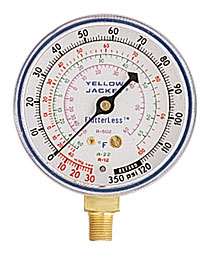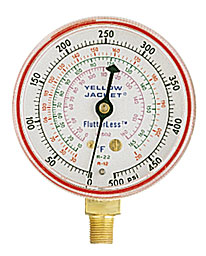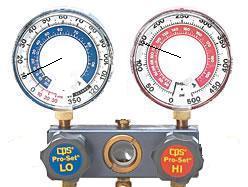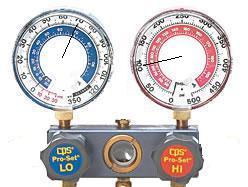
my InterDynamics (id) recharging gauge is as follows:
GREEN = LOW = 0-25 PSI --> Recharge
BLUE = NORMAL = 25-45 PSI --> Filled, ok
YELLOW = ALERT = 45-65 PSI --> Overfilled of malfunction
RED = DANGER = 65-225 PSI --> Turn off the airco and visit an AC specialist
-------------
Manifold instructions:
1) Connect the low side hose (blue) to the low side port on the A/C unit.
2) Step 2Connect the high side hose (red) to the high side port on the A/C unit.
3) Step 3Open both valves so that the gauges register the A/C system pressure.
4) Compare the actual PSI readings to the normal PSI readings with the A/C
system in the "off" position (static pressure). The normal reading on both the
high side and the low side should be 80 to 105 PSI (R134a, 25C).
5) Turn the A/C system on to "max/high" output. With the engine speed at about
1,000 RPMs, check the low side PSI reading, which should be about 20 to 40
PSI(R134a, 25C), then check the high side PSI reading, which should be about 225
to 300 PSI (R134a, 25C). If the PSI readings are lower than normal, hook up a
can of refrigerant to the yellow (supply) hose and add enough refrigerant to the
system to bring the PSI readings up to the normal ranges.
-------------
Troubleshooting with Gauges FAQ
A visitor comes to us with questions about what might be wrong with the a/c in
their car. It goes something like this. My air conditioning was working last
week, and then it quit working. What do you think is wrong? Or, maybe something
like this... I added some refrigerant to my car, and it still won't get cold.
What could be wrong? Well, unfortunately, questions like that are almost
impossible to answer without detailed information. That's where the manifold
gauge set comes into play. We use a manifold gauge set to get more information
about what's happening inside the system. We created this FAQ to help answer
some of the most common questions we receive on using a gauge set and hopefully
provide some explanation on pressure readings.
As a prerequisite, anyone interested in learning how to use a gauge set should
first take a few moments to learn how the refrigeration cycle works and
understand how refrigerant flows through the system. This in itself will help
you immensely when it comes time to identify the high and low side of the
system. You'll also begin to understand the role pressure plays on different
parts of the system. That's important, since the gauge set is used to measure
pressure within the system.
The basic manifold gauge set
The basic manifold gauge set usually has three hoses. Two hose will be attached
to the service ports on the vehicle during service. Each hose has its own
identifying color. In most cases, the hose intended for the low pressure service
port is blue, and the hose intended for the high pressure service port is red.
The middle hose should be yellow. That yellow hose will be attached to the
refrigerant cylinder while charging or the vacuum pump when the system is being
evacuated of air and moisture. Your manifold gauge set should have a
corresponding gauge and control knob for each of the two service hoses. Like the
color of the hose, the gauges and control knobs will usually be colored to
indicate high or low pressure.
What are all the numbers on the high and low side gauge?
The low side pressure gauge is called a compound gauge. That means it can be
used to measure pressure or vacuum. The numbers around the outside of this gauge
indicate pressure in pounds per square inch (PSIG), and the numbers near the
bottom indicate vacuum in inches of mercury. The smaller scales near the middle
of the gauge list the temperature relationship of different refrigerants. The
gauges pictured here lists the temperature of R12, R22, and R502. Regardless of
which refrigerant is being used, the scale designated as PSI is the one used to
read system pressures when charging and diagnosing an a/c system. The working
pressure of this gauge is from 0 to 120 PSI.
The red, high side gauge is used to measure the high pressure side of the a/c
system. This gauge has no markings that indicate vacuum. It reads positive
pressure only. The working pressure of this gauge is also much higher than the
low side gauge. Notice the scale on this high side gauge reads from 0 to 500 PSI
I hooked up the service hoses with the car turned off. Both gauges show
pressure. What does this mean?
The pressure readings you see when the a/c system is not operating is called
static pressure. When the system is off, and temperature is stable, the pressure
you see on both the high and low side gauges should be the same, or very close.
Both the high and low side of the system have equalized.
What static pressure should I expect to see when I hook up my gauge set.
Each refrigerant has it's own static pressure at every corresponding degree in
temperature. The important thing to keep in mind is static pressure changes
based on temperature. Any change of temperature brings with it a change of
pressure. The greater the temperature, the greater the pressure. You can use a
refrigerant pressure chart to find static pressures at various temperatures.
Static pressure will not be used to determine if a system is fully charged.
Using the chart below, if the R-134a system has a static pressure of 88 psi at
80 degrees F., we can then assume the system has some amount of liquid
refrigerant. The system may be full -or - may not be. At the same temperature,
if the system showed only 75 psi, we could say with confidence, the system is
low. This is because static pressures shown on a temperature chart would show
inadequate pressure for the presence of any liquid refrigerant.
<pressure chart> - Coming soon
Can I tell if the system is full with a static pressure reading?
No. We might determine if there is liquid refrigerant in the system, but we
won't be able to tell how much liquid it contains. For example, a thirty pound
can of refrigerant will show the same pressure whether it has thirty pounds in
it or if it only has 1 ounce. With static pressure, you will only know if the
system has some amount of liquid refrigerant present.
What good is a static pressure reading then?
With our initial pressure reading, we can tell if the system has enough pressure
to satisfy the low pressure switch and enable the compressor to operate. Static
pressure is used to determine if a jug of refrigerant is contaminated with air.
Static pressure can also be used to determine if a system has enough pressure to
begin leak testing. Your static pressure should be no lower than 50 psi when
leak testing.
What's the minimum static pressure I need for the compressor to operate?
Most systems will have a low pressure cut off switch that turns the system off
at approximately 20 psi. The compressor will not function again until the
pressure reaches approximately 45 psi. So, In most cases, you will need a static
pressure of at least 45 psi before you begin to see the compressor operate.
Can I test the system with only 45 psi?
You can begin testing with only 45 psi. You won't get any cold air, but you
should should start to see some compressor engagement. As soon as the compressor
engages, it will cycle off rather quickly when the suction side of the
compressor draws the pressure on the low side below 20 psi.. You will see the
low side gauge at 45 psi, drop quickly to 20 psi, at which point the compressor
will cycle off. Then the low side gauge will climb back up to 45 psi as the high
and low side equalize. At this point, he compressor will kick back on and the
cycle will repeat itself. This is called short cycling. This rapid cycling of
the compressor is a good indication that the system is low of refrigerant.
When charging, what should my low and high side pressure be?
Ah, this is the most asked question there is. There is no magic answer for this
question though. There are too many variables. Compressor (engine) RPM and
airflow across the condenser are always changing, thus engine speed is always
affecting pressure. System design, blower speed, mode setting, refrigerant type,
all cause variance in high and low side pressure. For this reason we simply
can't say 30 on the low side and 200 on the high side. Though I might add,
that's about where you'll usually end up. The reason 30 psi on the low side is
just about right is because that translates into an evaporator temperature
somewhere around the freezing point of water. Look at your low side R12 gauge
and you'll see a temperature scale right next to your pressure scale. That low
side pressure translates into evaporator temperature. Since moisture collects on
the evaporator, we would like to keep the evaporator temperature slightly above
the freezing point. R134a low side pressure will be be slightly lower (27 PSI)
at this temperature. Again, refrigerant type is one of those variables we have
to consider.
What should the high side pressure be?
With R12 systems, high side pressure is usually 1.8 to 2.1 times ambient
temperature. That means on an 80 degree day, with moderate humidity, we would
expect to see between 144 to 168 PSI on the high side. On hot humid days (with
R12), you could say ambient temperature plus 100 PSI., and be pretty close.
With R134a it's common to see high side pressure between 2.2 and 2.5 times
ambient temperature. On that same 80 degree day we would see between 176 and 200
PSI on the high side of an R134a system. The system operates in a specific range
based on outside ambient temperature. High side pressure has a broad range
relative to temperature because of heat load on the evaporator, humudity,
airflow across the condenser, and engine speed.
Should I test with doors open or closed, high idle, blower on high or low?
We should measure high and low side pressure at stable engine speeds. This can
be done at engine speeds just slightly above idle. 1,200 to 1,500 RPM is most
often recommended. On front wheel drive cars, never rev the engine or hold the
engine at high RPM while charging or checking pressures. This can create
dangerous high pressure. This is because electric condenser fans are fixed in
speed, and will not compensate for high engine RPM. The same holds true on rear
wheel drive cars with engine driven fans. A defective fan clutch could cause
pressures to reach dangerous levels at higher engine RPM.
We like to test with the system in MAX position on high blower with doors
closed. Windows can be open. MAX (recirculate) mode is preferred since we'll
need to have the hood up while charging and testing. In fresh air mode, hot
engine heat can be drawn into the fresh air cowl under the wiper blades. Same
reason we would like to test with doors closed. We would like to keep engine and
exhaust heat from causing abnormal heat load on the evaporator. We're not
bothered by having the windows down, since this helps create a typical and
stable heat load. And it's easy to reach in and feel how cold the vent temps are
getting.
Testing should be done with blower speed on high. Low blower speed will reduce
heat load on the evaporator to the point where compressor cycling can occur. We
want nice stable conditions when testing. When needed, low blower speed can be
used to force low side pressure down during testing and adjustment of compressor
cut-out pressure.
If 30 PSI is a good low side pressure, then why isn't the system cooling?
Well, there are a couple reasons, but let's look at the most common. Let's take
the fixed orifice tube system for example. You can have a system evaporator
pressure of 30 psi, and still be low on refrigerant. Let's assume that only half
the evaporator is full of boiling, heat removing, liquid refrigerant. Only half
the air traveling through the coil is being cooled. Pressure readings indicate
core temperature is near thirty degrees, but half the core isn't removing any
heat. The system is close to being full, but that discharge air is only slightly
cool. On the fixed orifice tube system, most people will charge until the inlet
of the evaporator, and the outlet of the evaporator are within a degree or two
of each other. That indicates the quantity of refrigerant is enough that the
entire coil is being used. At this point, the boiling liquid will spill into the
accumulator, thus the outlet tube will be very cold. If the system has a TXV or
H block, you will not be able to charge by feeling the evaporator outlet tube
like we can on a FOT system. The TXV is very efficient and is designed to
tightly control liquid refrigerant from spilling out of the evaporator. The area
we would measure is in the evaporator box, and not accessible for this purpose.
Secondly, who says the system isn't working. You need to consider the chance of
a blend door problem. Just because cold air isn't coming from the vent doesn't
mean the system isn't working. I've seen cars with sweat rolling off the
accumulator and low pressure line to the compressor, and the technician is under
the hood scratching his head because no cold air is coming from the vents. If
the low side lines are obviously cold, and pressures are within range, we should
think about looking inside the vehicle for the problem.
How can I tell if the compressor is bad?
Usually the compressor will show the inability to generate enough suction and
pressure at or near idle speeds.
If engine speed needs to be substantially increased to bring pressures in range,
that's a sign that the compressor is getting weak. Often the complaint is...
only cools when the engine is reved - or - only cools when driving down the
road.
Sometimes it's very simple. If we hook the gauges up and see 80 psi on the low
side, and 80 psi on the high side, and the compressor hub is spinning, it's
likely that compressor is done. It's not producing suction, and it's not
producing pressure. We could add or remove refrigerant and still nothing would
happen. The compressor must be able to pull a vacuum, and create pressure.
Compressors that use a variable stroke are often misdiagnosed as being
defective, when only the internal pressure control device is at fault. See:
http://www.aircondition.com/tech/questions/53/
How can I tell if the orifice tube is clogged?
A restricted orifice will usually show as very low suction side pressure and
lower than normal high side pressure. When the compressor kicks in, the suction
against the restricted orifice will cause the compressor to quickly cycle out.
After compressor disengagement, the rise in suction side pressure will usually
be very slow. Rapid compressor disengagement and slow engagement may indicate a
clogged orifice. A clogged orifice tube will starve a compressor of oil.
How can I tell if the expansion valve is bad?
This has to be our least favorite item to diagnose. We've had expansion valves
quit working while on the road and show no signs of problem back in the shop.
What's worse, an expansion valve can stick closed, stick open, or hang somewhere
in between.
Of all the bad expansion valves seen over the years, I think those that stick
closed are most common. Those are the easy ones. Gauges will show very low
suction side pressure along with lower than normal high side pressure. The low
side may even draw into a vacuum. That's a big clue. Those that appear to be
stuck closed may have inlet screens clogged with ground up desiccant particles.
This will look like beach sand packed into the inlet.
It's common for a defective expansion valve to stick closed, however, the
expansion valve can also stick open. This is indicated by higher than normal low
side pressure, and slightly higher than normal high side pressure. To some, this
might appear as a weak compressor or slightly overcharged system.

AC charge instructions X1-9_501-03_50-5.pdf
Low side gauge:
and the high side gauge:
----------------
Additional Car A/C Info – Troubleshooting Gauge Readings
With the AC on the coldest setting, use a thermometer in a middle vent. Normal
vent temperature readings will vary depending on the (ambient) outside temp. The
vent temperature should range from around 42-55 degrees in my experience. If
normal gauge readings are obtained and the vent air is cold – STOP don’t
overcharge the system. The only proper way to remove refrigerant is with a AC
recovery machine so if this is being done at home I can’t emphasize enough not
to over charge the system. And actually the best way to insure the proper charge
is in a system, is to use an AC machine to recover the freon and then evacuate
and recharge the system with the correct amount. Most cars have the specified
amount on a decal under the hood.

**AC_Gauge_Readings_Low.jpg
Both sides are lower than normal. Both low and high side readings are lower than
normal, this indicates a cars AC system is low on refrigerant and is
under-charged.

**AC_Gauge_Readings_Both_High.jpg
Both readings are higher than normal. If both low and high side readings are too
high, this indicates an overcharged system – too much refrigerant. This also can
indicate that the condenser fan is not working, is too slow or the car is
overheating and heat is transferring from the radiator to the condenser.

**AC_Gauge_Readings_In_Vacuum.jpg
Low side goes into a vacuum and high side is too high. When the low side goes so
low that it’s reading shows it is in a vacuum, the most likely cause is a bad
expansion valve or blocked orifice tube. Another possibility is a restricted
condenser. Blocked condensers are not as common as they used to be but if a
compressor fails and comes apart inside the remnants can end up in the condenser
causing it to restrict the flow of refrigerant.

**AC_Gauge_Readings_High_Low.jpg
Low side is too high and high side is too low. When the compressor clutch is
definitely engaged and the low side is high and the high side is low, the most
likely cause is that the compressor is failing – it is not pumping sufficiently.
Rarely an AC clutch could be slipping but usually this will be accompanied with
a squeal or chirp. Also be sure not to overlook the obvious, like a loose belt!
Question: I have to add a can of freon every two weeks, where could it be going?
Answer: Obviously, the system has a leak. Some cars come with UV dye in their
system already. Usually you can see some of the dye in the service port (a
little might show after disconnecting the gauge set hoses). Look for dye or
clear refrigerant oil on the AC components that would indicate a leak. In
addition to a visual inspection, an electronic leak detector can be used to
pinpoint the source of a leak
Question: Why is there such a big temperature change in the AC lines? Some are
very hot and some are cold is this normal?
Answer: The line going from the compressor to the condenser is the discharge
line – it is normal for it to be very hot to the touch. The other line going
from the drier or accumulator to the compressor is normally colder. The liquid
line can be hot up to the point an orifice tube is in place. Just remember that
LOW Pressure = COLD and HIGH Pressure = HOT.
http://www.denlorstools.com/autoblog/2009/04/adding-freon-to-car-ac-gauge-readings-explained